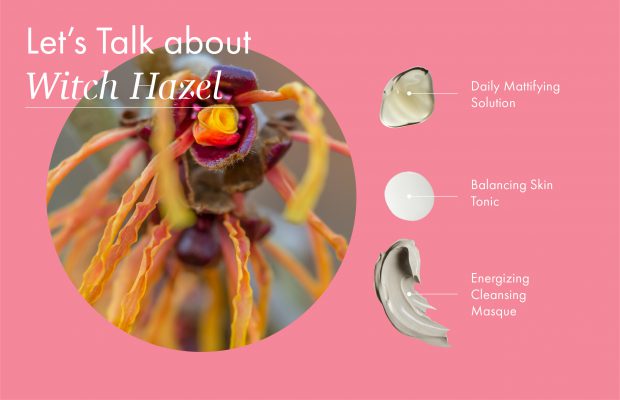Updated 04/16/24. From beauty to medicine, witch hazel is an ingredient with many uses and a long history. Before modern medicine, it was used to soothe wounds and promote healing. Fast forward a few centuries, and you might remember stories of people using Preparation H hemorrhoid cream—which contains witch hazel—to combat under-eye puffiness! (Spoiler alert: I don’t recommend this. The eye area is super sensitive and should only be exposed to products formulated specifically for this purpose.)
In the last few years, witch hazel has been relegated as an old-school ingredient that can cause dryness or irritation. It seems like everyone’s been made to fear this ingredient, but I think it’s just misunderstood, especially for oily and sensitive skin! In fact, witch hazel can have benefits for almost every skin type in the form of toners, face masks, and moisturizers, it’s just about finding a well-formulated product.
Witch hazel itself hasn’t changed over the years, but how we use it definitely has. Skincare products are now made to be much more gentle, with the skin’s protective barrier in mind. Thanks to more advanced extraction techniques, you can reap the therapeutic benefits of witch hazel without the drawbacks. It’s making a comeback, and it’s here to provide serious benefits in more ways than one! Keep scrolling to learn how it could benefit your skin (and how to avoid any possible downsides).
What Is Witch Hazel, and Where Does It Come From?
Witch hazel, or Hamamelis Virginianal, is a tree extract commonly used in cosmetics. It is native to Canada and the Eastern United States, but globalization has made cultivation possible in Europe as well. Extraction is typically done by blasting parts of the tree (such as the leaves, bark, and roots) with carbon dioxide. This stressor causes the plant to excrete an oil, which then leaves behind a watery substance that is essentially witch hazel essence. This water or “essence” is what’s used in your cosmetics.
What Is Witch Hazel Good For?
Witch Hazel has been around for hundreds of years, finding itself useful not only for skin care but also in wound healing. Native Americans used it to soothe wounds and irritation, and it’s now used as a vasoconstrictor in modern medicine.
When it comes to skincare, we primarily use witch hazel for its astringency effect. This happens because of molecules called tannins, which cause the proteins in the skin to tighten up. This helps tighten pores and is also what helps with healing.
Will Witch Hazel Dry Out My Skin?
Witch hazel’s astringent effect is exactly what makes people worry that it will dry out their skin. Many of us associate the word “astringent” with super drying toners of the 90s. The thing to understand is that if a substance is astringent, it really just means that it causes a slight contraction (aka tightening) of skin tissue when applied. People often associate this tighter feeling with dryness, but in this case, that’s not necessarily accurate. It’s true that if your pores are contracted, less oil will flow through them. But if you’re trying to control excessive oiliness, this is a benefit!
The thing about those toners in the 90s was that they often contained drying alcohols on top of being astringent. This was ultimately what dried out people’s skin and caused irritation. There was a time when so many of the clients who came to my spa were using a very popular 3-step skincare system that included an astringent toner. But on top of including drying alcohols, this toner also had acetone in it (yes, you read that right). I would literally use it to take off my nail polish as a way to demonstrate to clients how harsh it was.
The bottom line is that witch hazel has many benefits and is a great ingredient both for soothing sensitive skin and for reducing excessive oil production for those with oily skin. As always, it’s all about finding a product that’s formulated properly.
What Should You Look For When Purchasing Witch Hazel Products?
When looking for products with witch hazel, it’s crucial to keep in mind that the extraction method can significantly affect its properties. When looking for products with witch hazel, it’s crucial to keep in mind that the extraction method can significantly affect its properties. This applies whether you’re looking for a toner, face mask, or moisturizer, and whether your skin is just oily or also sensitive.
Some extractions may involve alcohol or have a high alcohol content—it depends on the reason for extraction. This ultimately means some products will have alcohol on the ingredient list. So, the first thing to do when starting your search for the perfect witch hazel product is to check the ingredient list for drying alcohols such as SD alcohol 40 or denatured alcohol. Steer clear of these and look for an alcohol-free witch hazel option.
Keep in mind that part of what gave witch hazel such an undeserved stigma back in the ’90s was that toners were made using it at (or near) a concentration of 100%. You don’t need to worry about that now. These days, when witch hazel is used in a product, it’s a small component of a product’s overall formulation. It’s only there to provide very mild astringency or anti-inflammatory properties. Most products these days also include hydrating ingredients, like glycerin, in conjunction with witch hazel. This creates a perfect balance and offsets any possible dryness.
As I always say, you shouldn’t judge a product by its ingredient label! In most cases, a single ingredient doesn’t make or break a product. It’s all about the quality of an ingredient, how much of it is used in a product, and how it’s combined with other ingredients.
Who Should Use Witch Hazel?
Due to the astringent effects of witch hazel, I largely recommend this ingredient for skin types 1-4. Those with oily and acne-prone skin are going to benefit the most from its oil-cutting capabilities. Since acne is an inflammatory condition, these skin types will also benefit from witch hazel’s anti-inflammatory properties.
In addition to curbing oil production, don’t forget that oily skin types still need hydration. Here are five ways to safely hydrate acne-prone skin.
Now, this isn’t to say that those with dry skin can’t benefit from witch hazel as well. This multifaceted ingredient can also provide wonderful benefits such as antioxidant and soothing qualities, as well as those wound healing capabilities I mentioned earlier. It all depends on which percentage of witch hazel is present, as well as if there are any other ingredients added to help combat its drying effects. There are several formulas containing witch hazel that add ingredients like humectants (hyaluronic acid, glycerin, etc.) to help attract water to the skin and keep it hydrated.
How Can You Incorporate This Ingredient Into Your Daily Routine?
Witch Hazel Toner
When people ask me, “Is witch hazel a good toner?” I always tell them yes. In fact, toners are the most classic method for delivering witch hazel. A gentle leave-on formulation, like Balancing Skin Tonic, is a great option because molecules in water-based skincare products can penetrate deeper into the skin than molecules in thicker products can. With an advanced blend of natural witch hazel, geranium, and niacinamide, this offers soothing hydration while diminishing post-breakout discolored marks and scarring.
Witch Hazel Face Masks
If you’re not currently in the market for a new toner, there are plenty of other great ways to incorporate witch hazel into your routine. It can be a great addition to face masks. Witch hazel and other pore-purifying extracts work together in Energizing Cleansing Masque to leave skin feeling tighter, firmer, and refreshed. The combination of antioxidants and nourishing botanicals allows this non-drying, clay mask to deliver cleaner pores and more refined skin.
Witch Hazel Moisturizer
Another great way to reap the benefits of witch hazel is through a moisturizer like Daily Mattifying Solution. The blend of witch hazel and hydrating ingredients is ideal for those with very oily skin, like Skin Type 1, who need hydration plus oil control.
If you were confused about some of the negativity surrounding witch hazel and wondering what its benefits are, I hope this post helps put your mind at ease and find some good reasons to include it in your routine! This ingredient has a long legacy in the skincare community and is just one of the many fantastic ingredients in any product formulator’s toolbox. It’s time to stop getting caught up in witch hazel’s troublesome past (and slightly spooky name) and start cheering on its well-deserved comeback.
Celebrity Esthetician & Skincare Expert
As an esthetician trained in cosmetic chemistry, Renée Rouleau has spent 30 years researching skin, educating her audience, and building an award-winning line of products. Her hands-on experience as an esthetician and trusted skin care expert has created a real-world solution — products that are formulated for nine different types of skin so your face will get exactly what it needs to look and feel its best. Trusted by celebrities, editors, bloggers, and skincare obsessives around the globe, her vast real-world knowledge and constant research are why Marie Claire calls her “the most passionate skin practitioner we know.”



